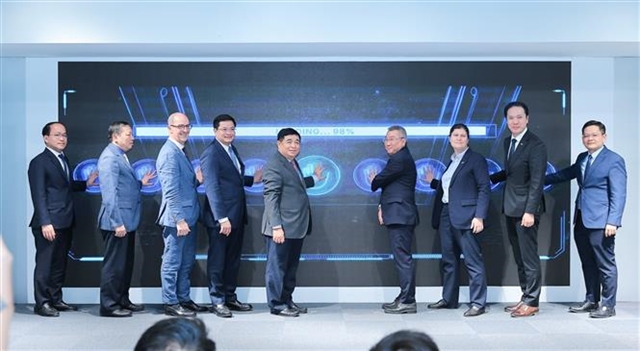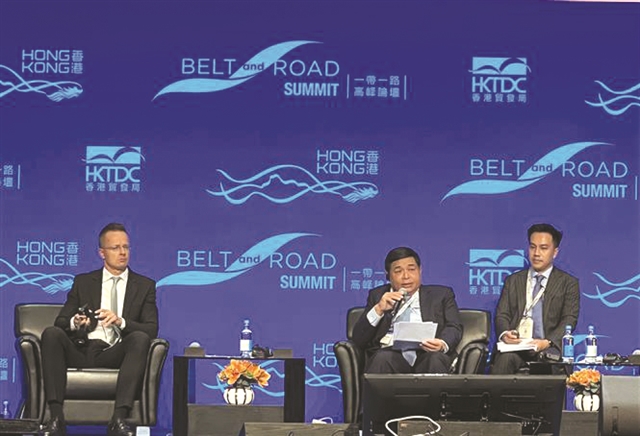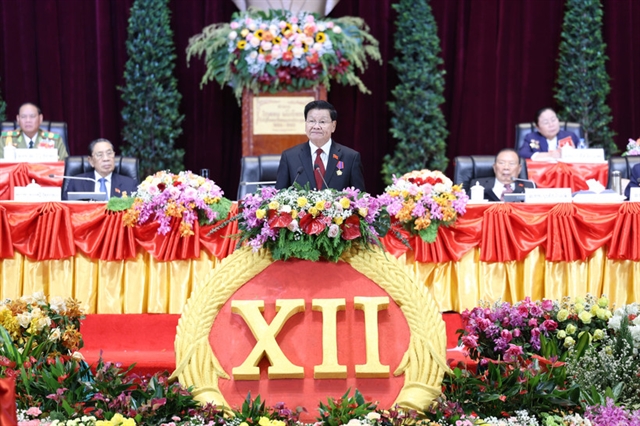 Economy
Economy

Over the past time, cooperation and connection between Việt Nam and China in general, and connection within the BRI framework in particular, have achieved some remarkable results, but some shortcomings need to be addressed.

|
| Minister of Planning and Investment Nguyễn Chí Dũng (second, right) speaks at the 8th Belt and Road Summit. VNA/VNS Photo Mạc Luyện |
Nguyễn Quốc Trường*
In 2017, Việt Nam and China signed and initially implemented a Memorandum of Understanding (MOU) on promoting connection between the Two Corridors, One Belt framework and the Belt and Road Initiative (BRI). Cooperation and connection between Việt Nam and China in general, and connection within the BRI framework in particular, have achieved some remarkable results, but some shortcomings need to be addressed.
Việt Nam - China cooperation in a new context
Development cooperation and connection between Việt Nam and China is taking place in the context of many changes in the regional and world situation, especially since 2018.
First, economic connection, in which transport infrastructure linkage is a focus, is becoming a major trend of countries in the region. Since 2013, the Asia-Pacific Economic Cooperation (APEC) Forum has identified an APEC connection plan until 2025 with three focus areas: institutional connection, physical connection (including infrastructure) and human connection. In Southeast Asia, a common community - the ASEAN Community (AC) - was born at the end of 2015 and countries in the region are actively implementing the Master Plan on ASEAN Connectivity 2025. BRI and other sub-regional cooperation initiatives also focus on the above-mentioned areas of connection. However, infrastructure connectivity in Southeast Asia in particular, and Asia-Pacific in general, is becoming one of the areas of competition between China and the US and Western countries.
Second, strategic competition between major countries, especially the US and China, is increasingly fierce, especially in the Asia-Pacific region, which has a profound impact on the process of globalisation and regional cooperation. The US and China have been exerting their influence on this region via their specific regional and global strategies and plans, including the implementation of initiatives, such as the BRI (initiated by China), and the Indo-Pacific Economic Cooperation Framework (led by the US).
Third, the global economy (including Việt Nam and China) is entering a difficult period in the "post-COVID-19" era. International organisations such as the IMF, WB, and OECD predict that world economic growth in 2023 will slow down, to only about 2.1 per cent (according to the WB), 2.7 per cent (according to the OECD). In China, in early 2023, many experts were optimistic that the economy would recover quickly after the pandemic, but in reality, the economy is facing some challenges, such as high unemployment, sluggish consumption demand, and a stagnant real estate sector. In Việt Nam, the economic growth rate in the first nine months of the year only reached 4.24 per cent and the growth target of 6.5 per cent for the whole year 2023 is forecast to be beyond reach. In the above context, promoting connectivity, finding opportunities for cooperation and economic development is an urgent need for both China and Việt Nam.
The situation of bilateral cooperation and implementation of BRI
(1) Connection between the Two Corridors, One Belt framework and the BRI
Việt Nam and China have signed and initially implemented a Memorandum of Understanding (MOU) on promoting connection between the Two Corridors, One Belt framework and the BRI. The MOU was signed on November 12, 2017, on the occasion of the visit to Việt Nam by General Secretary and President of China Xi Jinping. Accordingly, the two sides committed to cooperate and connect in five areas including policy connection, investment cooperation and infrastructure connection, trade connection, financial connection and human connection. Regarding the plan to promote the connection between the framework of Two Corridors, One Belt and the BRI, the Ministry of Planning and Investment is actively discussing with China's National Development and Reform Commission (NDRC) to complete and sign this draft plan in 2023.
(2) Cooperation on the new international corridor for land and sea trade
China is promoting the implementation of a New International Land-Sea Trade Corridor as part of the BRI. It is a trade and logistics passage jointly built by regions in western China and ASEAN members. This is a cargo route via rail-sea transportation from Chongqing through Guizhou, Guangxi and along the sea to important ports of some ASEAN countries such as Việt Nam, Thailand, Malaysia, and Singapore; and by road through Việt Nam, Laos, Cambodia, Thailand, Malaysia, to Singapore.
Currently, from Chongqing through Việt Nam, there are three types of transportation routes including road, rail, and sea that can connect Chinese ports (such as Fangcheng, Qinzhou in Guangzhou) with Vietnamese ports (such as Hải Phòng). Cargo trucks departing from Chongqing only take about three days to reach Hải Phòng. From 2017 up to now, many Chinese and Vietnamese transportation and logistics enterprises have transported hundreds of thousands of containers of goods from Chongqing through Việt Nam to ASEAN countries and from Việt Nam through China to third countries (Europe, Central Asian countries, Mongolia).
(3) Some other areas of cooperation
Infrastructure sector: The two sides have not yet implemented large projects of strategic connection. However, a number of cross-border traffic connection projects have been studied and implemented such as the feasibility study of the 1.435m gauge railway Lào Cai – Hà Nội – Hải Phòng; construction of Bắc Luân bridge in Móng Cái; and pilot cooperation in building a digital border gate between the two localities Lạng Sơn and Guangxi.
Investment and trade fields: From 2018 up to now, more and more Chinese businesses are interested in investing in Viêt Nam; China currently ranks 6th out of 143 countries and territories investing in Việt Nam. By the end of May 2023, Chinese investors have 3,720 investment projects in Việt Nam, with a total registered capital of US$24.9 billion. Regarding trade, bilateral trade turnover has increased continuously over the past years. Việt Nam is currently China's 4th largest trading partner in the world; two-way trade turnover in 2022 reached $175 billion. In the first five months of 2023, two-way trade turnover reached $63.2 billion, down 12.3 per cent over the same period last year, according to statistics from Vietnam Customs.
Other fields: Financial cooperation is still limited, mainly because Việt Nam has no need to use Chinese loans due to higher interest rates than other loan sources. Activities of human connection, people-to-people exchange, and cooperation between border localities of the two countries are robust.

|
| A freight train serving the International Land-Sea Trade Corridor departs from Chongqing for ASEAN markets in January. XINHUA/ VNS |
Shortcomings and recommendations
In reality, cooperation and connection between Việt Nam and China still have some limitations:
(1) Information exchange is limited, especially information relating to China's regional and sub-regional cooperation initiatives such as BRI, New International Corridor, planning and development orientation of border gates and border economic corridor;
(2) The negotiation, signing and implementation of cooperation documents the two countries have signed related to cross-border economic connection have not met expectations;
(3) There are still some "bottlenecks" in economic cooperation and connection between the two sides, especially in the fields of trade cooperation and infrastructure connection. There are no strategic connection projects between the two sides.
To promote development connection between Việt Nam and China in general, connecting the Two Corridors, One Belt framework with the BRI in particular, the two sides should strengthen cooperation on the following aspects:
(1) Soon sign the plan to promote connectivity between the Two Corridors, One Belt framework and the BRI, as a basis for implementing specific connection tasks and projects. In addition, in BRI cooperation, the role of Hong Kong should be paid more attention to. Hong Kong should be considered an important bridge to connect Vietnamese and Chinese markets and businesses.
(2) Ministries, agencies and localities of the two countries need to be more active and proactive in connecting policies and exchanging information. Some specific contents that can be jointly studied include a study to expand the scope of cooperation on Two Corridors, One Belt framework to Chongqing; a feasibility study of the Lạng Sơn – Hà Nội – Lạch Huyện railway (1.435m gauge); exchange of information on border gate planning and smart border gate construction; and sharing experience in building and managing international trade ports.
(3) The two countries need to actively cooperate and focus on resolving bottlenecks in border crossing procedures such as customs, and quarantine to reduce transportation time, reduce costs, and increase competitiveness for logistics businesses and exported goods of both sides. The Vietnamese side should actively push the Chinese side to open its market further for Vietnamese goods, especially agricultural products.
(4) Việt Nam needs to boost infrastructure connecting with China, especially in border areas; pay more attention to promoting strategic infrastructure connection projects, such as 1.435m gauge railway projects under Two Corridors, One Belt (already included in the National Railway Network Planning to 2030).
(5) Việt Nam and China should strengthen people-to-people exchanges and cooperation and exchanges between border localities. Cooperation with border localities and localities on the New International Land-Sea Trade Corridor (Guangxi, Chongqing) is an important solution to maintaining Việt Nam's "bridging" role in connecting China - ASEAN. At the same time, the two countries should quickly restore the People's Friendship Forum and people-to-people exchange activities as before the COVID-19 pandemic.
Nguyễn Quốc Trường is Deputy Director of the Vietnam Institute for Development Strategies under the Ministry of Planning and Investment




